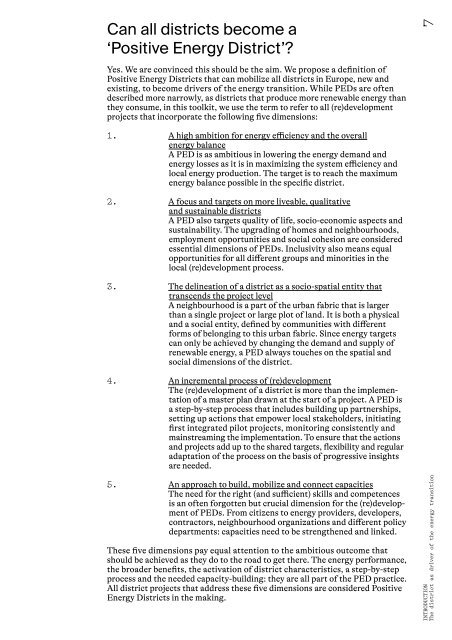Powering the energy transition at the district level_Cities4PEDs_AWB_final
Create successful ePaper yourself
Turn your PDF publications into a flip-book with our unique Google optimized e-Paper software.
Can all <strong>district</strong>s become a<br />
‘Positive Energy District’?<br />
7<br />
Yes. We are convinced this should be <strong>the</strong> aim. We propose a definition of<br />
Positive Energy Districts th<strong>at</strong> can mobilize all <strong>district</strong>s in Europe, new and<br />
existing, to become drivers of <strong>the</strong> <strong>energy</strong> <strong>transition</strong>. While PEDs are often<br />
described more narrowly, as <strong>district</strong>s th<strong>at</strong> produce more renewable <strong>energy</strong> than<br />
<strong>the</strong>y consume, in this toolkit, we use <strong>the</strong> term to refer to all (re)development<br />
projects th<strong>at</strong> incorpor<strong>at</strong>e <strong>the</strong> following five dimensions:<br />
1. A high ambition for <strong>energy</strong> efficiency and <strong>the</strong> overall<br />
<strong>energy</strong> balance<br />
A PED is as ambitious in lowering <strong>the</strong> <strong>energy</strong> demand and<br />
<strong>energy</strong> losses as it is in maximizing <strong>the</strong> system efficiency and<br />
local <strong>energy</strong> production. The target is to reach <strong>the</strong> maximum<br />
<strong>energy</strong> balance possible in <strong>the</strong> specific <strong>district</strong>.<br />
2. A focus and targets on more liveable, qualit<strong>at</strong>ive<br />
and sustainable <strong>district</strong>s<br />
A PED also targets quality of life, socio-economic aspects and<br />
sustainability. The upgrading of homes and neighbourhoods,<br />
employment opportunities and social cohesion are considered<br />
essential dimensions of PEDs. Inclusivity also means equal<br />
opportunities for all different groups and minorities in <strong>the</strong><br />
local (re)development process.<br />
3. The deline<strong>at</strong>ion of a <strong>district</strong> as a socio-sp<strong>at</strong>ial entity th<strong>at</strong><br />
transcends <strong>the</strong> project <strong>level</strong><br />
A neighbourhood is a part of <strong>the</strong> urban fabric th<strong>at</strong> is larger<br />
than a single project or large plot of land. It is both a physical<br />
and a social entity, defined by communities with different<br />
forms of belonging to this urban fabric. Since <strong>energy</strong> targets<br />
can only be achieved by changing <strong>the</strong> demand and supply of<br />
renewable <strong>energy</strong>, a PED always touches on <strong>the</strong> sp<strong>at</strong>ial and<br />
social dimensions of <strong>the</strong> <strong>district</strong>.<br />
4. An incremental process of (re)development<br />
The (re)development of a <strong>district</strong> is more than <strong>the</strong> implement<strong>at</strong>ion<br />
of a master plan drawn <strong>at</strong> <strong>the</strong> start of a project. A PED is<br />
a step-by-step process th<strong>at</strong> includes building up partnerships,<br />
setting up actions th<strong>at</strong> empower local stakeholders, initi<strong>at</strong>ing<br />
first integr<strong>at</strong>ed pilot projects, monitoring consistently and<br />
mainstreaming <strong>the</strong> implement<strong>at</strong>ion. To ensure th<strong>at</strong> <strong>the</strong> actions<br />
and projects add up to <strong>the</strong> shared targets, flexibility and regular<br />
adapt<strong>at</strong>ion of <strong>the</strong> process on <strong>the</strong> basis of progressive insights<br />
are needed.<br />
5. An approach to build, mobilize and connect capacities<br />
The need for <strong>the</strong> right (and sufficient) skills and competences<br />
is an often forgotten but crucial dimension for <strong>the</strong> (re)development<br />
of PEDs. From citizens to <strong>energy</strong> providers, developers,<br />
contractors, neighbourhood organiz<strong>at</strong>ions and different policy<br />
departments: capacities need to be streng<strong>the</strong>ned and linked.<br />
These five dimensions pay equal <strong>at</strong>tention to <strong>the</strong> ambitious outcome th<strong>at</strong><br />
should be achieved as <strong>the</strong>y do to <strong>the</strong> road to get <strong>the</strong>re. The <strong>energy</strong> performance,<br />
<strong>the</strong> broader benefits, <strong>the</strong> activ<strong>at</strong>ion of <strong>district</strong> characteristics, a step-by-step<br />
process and <strong>the</strong> needed capacity-building: <strong>the</strong>y are all part of <strong>the</strong> PED practice.<br />
All <strong>district</strong> projects th<strong>at</strong> address <strong>the</strong>se five dimensions are considered Positive<br />
Energy Districts in <strong>the</strong> making.<br />
INTRODUCTION<br />
The <strong>district</strong> as driver of <strong>the</strong> <strong>energy</strong> <strong>transition</strong>

















